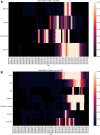"But Mouse, You Are Not Alone": On Some Severe Acute Respiratory Syndrome Coronavirus 2 Variants Infecting Mice
- PMID: 35022734
- PMCID: PMC9236659
- DOI: 10.1093/ilar/ilab031
"But Mouse, You Are Not Alone": On Some Severe Acute Respiratory Syndrome Coronavirus 2 Variants Infecting Mice
Erratum in
-
Erratum to: "But Mouse, You Are Not Alone": On Some Severe Acute Respiratory Syndrome Coronavirus 2 Variants Infecting Mice.ILAR J. 2021 Dec 31;62(1-2):274. doi: 10.1093/ilar/ilac002. ILAR J. 2021. PMID: 35194636 Free PMC article. No abstract available.
Abstract
In silico predictions combined with in vitro, in vivo, and in situ observations collectively suggest that mouse adaptation of the severe acute respiratory syndrome 2 virus requires an aromatic substitution in position 501 or position 498 (but not both) of the spike protein's receptor binding domain. This effect could be enhanced by mutations in positions 417, 484, and 493 (especially K417N, E484K, Q493K, and Q493R), and to a lesser extent by mutations in positions 486 and 499 (such as F486L and P499T). Such enhancements, due to more favorable binding interactions with residues on the complementary angiotensin-converting enzyme 2 interface, are, however, unlikely to sustain mouse infectivity on their own based on theoretical and experimental evidence to date. Our current understanding thus points to the Alpha, Beta, Gamma, and Omicron variants of concern infecting mice, whereas Delta and "Delta Plus" lack a similar biomolecular basis to do so. This paper identifies 11 countries (Brazil, Chile, Djibouti, Haiti, Malawi, Mozambique, Reunion, Suriname, Trinidad and Tobago, Uruguay, and Venezuela) where targeted local field surveillance of mice is encouraged because they may have come in contact with humans who had the virus with adaptive mutation(s). It also provides a systematic methodology to analyze the potential for other animal reservoirs and their likely locations.
Keywords: AlphaFold; in silico; in vitro; in vivo; COVID-19; SARS-CoV-2; animal reservoir; mouse adaptation; variants.
© The Author(s) 2021. Published by Oxford University Press on behalf of the National Academies of Sciences, Engineering, and Medicine.
Figures



References
-
- Lassaunière R, Fonager J, Rasmussen, M, et al. Working paper on SARS-CoV-2 spike mutations arising in Danish mink, their spread to humans and neutralization data. 2020. https://files.ssi.dk/Mink-cluster-5-short-report_AFO2. Accessed December 1, 2020.
Publication types
MeSH terms
Substances
Supplementary concepts
LinkOut - more resources
Full Text Sources
Medical
Miscellaneous

